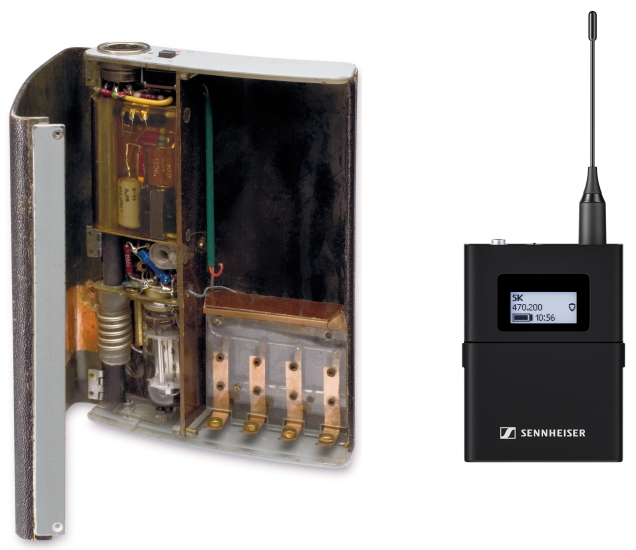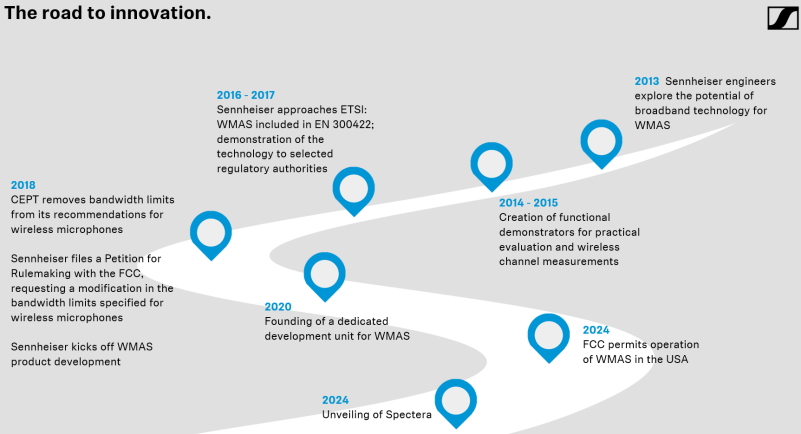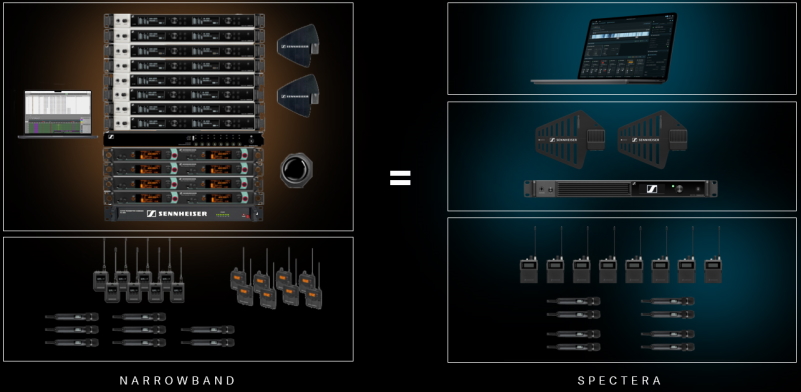The Birth of Sennheiser WMAS

Dr Andreas Wilzeck
With Spectera, Sennheiser has unveiled the world’s first bidirectional wireless wideband ecosystem, which is based on the company’s research into Wireless Multichannel Audio Systems, or WMAS for short. While finetuning of Spectera continues in collaboration with players in the professional audio industry, Andreas Wilzeck, head of Sennheiser’s Spectrum Policy and Standards team, takes a look back at the “birth” of WMAS in his latest technical paper.
Dr Wilzeck, before we touch on the topics of your paper, can you briefly explain what WMAS is and why it is a ‘gamechanger’ in wireless audio? The term gamechanger seems to be in heavy usage these days…
(laughs) That’s true, but I hope that I can sufficiently demonstrate to you how this technology will truly bring massive advantages to professional audio users in terms of ease of use, flexibility and reliability, all the while solving many of the pain points that frequency coordinators, operators, or rental companies have regarding wireless audio today.
Since the first wireless microphones surfacing in the 1950s and, much later, the wireless in-ear monitor (IEM), transmission has always happened in a narrowband, 200 kHz bandwidth 1:1 scheme, meaning that each mobile wireless microphone or IEM receiver has its stationary or rack-mount counterpart. In the following decades, the professional audio world has seen the move from VHF to the more reliable UHF frequencies, the invention of noise reduction systems for analogue RF transmission, and finally the triumph of digital wireless systems, but this 200 kHz narrowband RF transmission has remained the same throughout.

Then two Sennheiser developers tried something completely new, namely to look into how wideband techniques like OFDM and TDMA can be adapted to meet the stringent demands of professional wireless audio. That was back in 2013, and in September of 2024, we officially unveiled Spectera, an ecosystem based on this WMAS research. It is bidirectional and can run IEMs and mics in the very same 6 or 8 MHz wide TV channel, which hosts all audio and control data. Also, it can accommodate up to 64 audio links in a single, 1 U rack-mount base station – just think of the smaller footprint!
You said research started in 2013, that’s quite a long time ago, isn’t it?
As I explain in my paper, there is considerable engineering work, legal consideration and regulatory work to be done before an idea for a new kind of wireless transmission can become a product. Using a wideband transmission scheme for the first time doesn’t just mean working on new technology. It also requires standardization to be adapted, as well as spectrum access regulations to be changed for every country on the globe.
At that time, Sennheiser, as the inventor of WMAS, was the sole manufacturer capable of showcasing fully functional WMAS prototypes to regulatory authorities and standardization bodies, and therefore played a crucial role in demonstrating the technology’s potential. We proposed inclusion of WMAS in the ETSI EN 300 422 standard as early as in 2014, and also became instrumental in creating the first version of the WMAS system reference document ETSI TR 103 450.
What would you say was the turning point in this regulatory work? When did WMAS have its breakthrough?
That was in 2018, when bandwidth restrictions for audio PMSE – program making and special events – were eliminated in the CEPT region, meaning Europe. In that same year, Sennheiser kicked off product development, and filed a “Petition for rulemaking” with the FCC to start the approval process in the USA. This process concluded six years later with the final rules being listed in the federal register on 18 October 2024.

In your paper, you write about effectiveness and efficiency in spectrum usage, which is stipulated by the Radio Equipment Directive (RED). In a world that is trying to be as efficient as possible, how can a wireless system become more efficient?
Let’s take a quick look at effectiveness first, as this is fundamental to all features of efficient spectrum use. The key driver of effective use of spectrum is the larger bandwidth that WMAS operates with by employing advanced modulation techniques such as OFDM and multiple access schemes such as TDMA or FDMA. These pave the way for having audio links with different direction in the same RF channel, for reducing fading, for continuous system control and management, and for allowing more wireless users in a given area.
Efficiency gains result mainly from bidirectionality, these would comprise remote control and management without additional infrastructure, flexible device configuration, intelligent transmitters, dynamic resource allocation within the RF channel, but certainly also the improved workflows and time savings for the operator.

WMAS is particularly suited for multichannel, high-density environments, examples would be theatre districts like the West End or Broadway, but also large festival grounds. With narrowband transmitters, their transmission power adds up, so if I have a theatre stage with say 30 or 50 wireless mics – which is standard for a theatre play or musical – I will get 30 or 50 times the transmission power of a single transmitter. If that happens to be 50 mW, we are speaking about 1.5 to 2.5 watts emanating from that stage. This means that a second stage in the same house or even a neighbouring theatre may no longer be able to use these frequencies. With Spectera, which uses TDMA so only has one device transmitting at any given time, the total transmit power remains at just 50 mW. This makes it much easier to reuse frequencies over distance, with every wall helping, too.
Does this mean that Spectera will kill all narrowband transmission?
Certainly not. As the name WMAS suggests, we are speaking about multichannel applications. If only a few wireless microphones will be used in an application, say you only have one or two artists performing at an event, these mics will likely always be narrowband links, simply because of price points. Spectera comes into the game especially when both IEMs and mics are used. By the way, Spectera and WMAS have proven their friendly co-existence with narrowband wireless in numerous tests.
I’ve seen criticism that Spectera always requires an entire TV channel, which would be occupying too much spectrum.
Spectera represents a forward-thinking approach to professional wireless audio. We are speaking about multichannel use cases, and here, mics and IEMs will definitely occupy more than just one TV channel if less efficient narrowband technology is used. My technical paper includes a comparison of audio channels per MHz for analogue wireless, digital wireless with different equidistant spacings, and Spectera, and you can quite clearly see that Spectera will enable the operator to accommodate more channels. These are both mics and IEMs at the same time, mind you, in the same 6 or 8 MHz wide RF channel.
Workflows and handling become easier with Spectera, too: As the base station auto-arranges its audio channels within the wideband transmission on a single RF carrier, you not only save yourself tedious frequency calculations, but also the complex cabling for large rack setups. And for peace of mind, Spectera gives you full control and monitoring capabilities, where you can even see what is happening on the frequencies you are using – which has never been possible until now.
So the statement should rather be the other way round: If I only have one TV channel for mics and in-ears, Spectera will save the show. Even with minimal spectrum resources, operators can deploy complex audio setups without compromising performance.
In your paper, you mention a multicast mode, which sounded quite interesting. Can you explain?
Spectera’s multicast IEM functionality allows up to 128 devices to receive the same audio feed simultaneously, and is ideal for productions or events where numerous performers need the same audio. For instance, a dance troupe could listen to a multicast mix with 0.7 ms latency in dual mono (stereo) with a high-quality SeDAC codec and utilize only 25% of the capacity of the wideband transmission of Spectera. This leaves 75% for other purposes, like, for example, vocals, instruments, and talkback.
What would you say if you had to define Spectera in three words?
Ah, there would have to be a few more, but let’s choose ease of use, performance, flexibility.
Is there anything else you would like to add?
Perhaps I should give a few more explanations on flexibility. What does this mean for the operator? Spectera works with audio modes, which he or she can select individually per device, and separately for mic and IEM. The audio modes differ in latency, codec – so data rate – range, and battery runtime. Some modes apply to IEM only, mic only, or both IEM and mic. These modes enable the operator to select exactly what is needed in the situation at hand, and make the best use of the available spectrum – which again supports the RED requirements of effectiveness and efficiency.
Thank you very much for the interview, Dr Wilzeck. What’s next on your agenda?
Together with our APAC colleagues, my team and I are visiting the individual regulators in the APAC region to get bandwidth limits removed for WMAS technology. WMAS is already allowed in Singapore, Australia (indoor), Malaysia, Philippines, Indonesia, Bhutan, with Vietnam, Taiwan and Hong Kong potentially following soon.
Best of luck for your endeavours.
 How to resolve AdBlock issue?
How to resolve AdBlock issue?